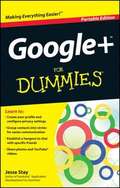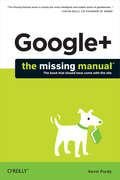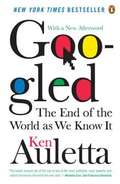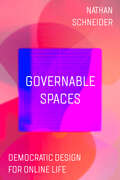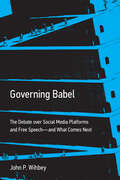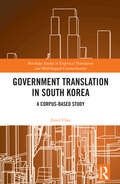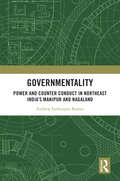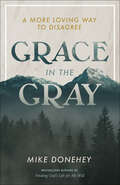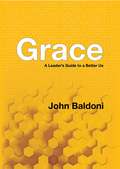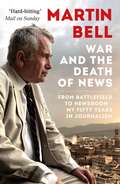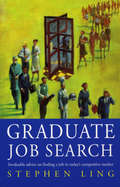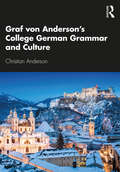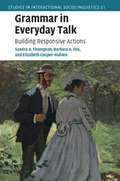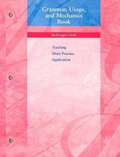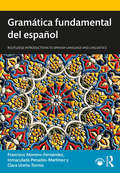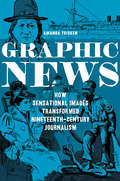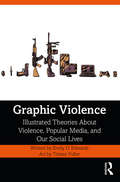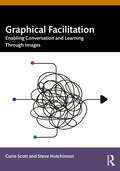- Table View
- List View
Google+ For Dummies, Portable Edition
by Jesse StayA new social network! Here's your user's guide to Google+ Google+ is Google's new social network and from day one it has had the social media world abuzz with excitement. Early fans claim it's easier to use than Facebook and Twitter and has a wealth of creative new features. If you want to learn how to navigate this new social neighborhood, take along Google+ For Dummies as your guide. Early Google+ adopter and social media consultant Jesse Stay shows you how to get started, create a profile, set up privacy settings, chat, post, control who sees what, and much more. Explains how to join Google+, protect your information, and make the most of this new social network Explores cool new features, such as Circles, which allows you to drag and drop friends into different circles Covers creating a profile, finding friends, adding people to Circles, chatting with others in Hangouts, importing photos, controlling who sees what, and more Conveys helpful information in the clear, friendly, easy-to-follow language that has defined the Dummies series for two decades Confidently enter the exciting new Google+ social neighborhood with Google+ For Dummies.
Google+: The Missing Manual
by Kevin PurdyIf you want to gain more control over your social networking activities with Google+, this jargon-free guide helps you quickly master the ins and outs of the site. Learn how to organize your contacts, hold video chats with as many as ten people, and determine exactly who may learn what about you. With this book, you'll navigate Google+ with ease. The important stuff you need to know Massage your profile. Control what the public, specific groups, or certain individuals can see about you. Move in the right circles. Assign folks to different groups and share the right stuff with the right people. Jump into streams. Get all the updates, pictures, and links from people you know. Host hangouts. Organize and attend group video chats. View and share photos. Make them available to whomever you like--whether or not they're Google+ members. Get notifications. Monitor what others do (and share about you) on Google+. Go mobile. Use Google+ on your Android, iPhone, or mobile web browser.
Google+: The Missing Manual (Oreilly And Associate Ser.)
by Kevin PurdyIf you want to gain more control over your social networking activities with Google+, this jargon-free guide helps you quickly master the ins and outs of the site. Learn how to organize your contacts, hold video chats with as many as ten people, and determine exactly who may learn what about you. With this book, you’ll navigate Google+ with ease.The important stuff you need to knowMassage your profile. Control what the public, specific groups, or certain individuals can see about you.Move in the right circles. Assign folks to different groups and share the right stuff with the right people.Jump into streams. Get all the updates, pictures, and links from people you know.Host hangouts. Organize and attend group video chats.View and share photos. Make them available to whomever you like—whether or not they’re Google+ members.Get notifications. Monitor what others do (and share about you) on Google+.Go mobile. Use Google+ on your Android, iPhone, or mobile web browser.
Googled
by Ken AulettaThere are companies that create waves and those that ride or are drowned by them. This is a ride on the Google wave, and the fullest account of how it formed and crashed into traditional media businesses. With unprecedented access to Google's founders and executives, as well as to those in media who are struggling to keep their heads above water, Ken Auletta reveals how the industry is being disrupted and redefined. Auletta goes inside Google's closed-door meetings, introducing Google's notoriously private founders, Larry Page and Sergey Brin, as well as those who work with - and against - them. In Googled, the reader discovers the 'secret sauce' of the company's success and why the worlds of 'new' and 'old' media often communicate as if residents of different planets. It may send chills down traditionalists' spines, but it's a crucial roadmap to the future of media business: the Google story may well be the canary in the coal mine. Googled is candid, objective and authoritative. Crucially, it's not just a history or reportage: it's ahead of the curve and unlike any other Google books, which tend to have been near-histories, somewhat starstruck, now out of date or which fail to look at the full synthesis of business and technology.
Googled
by Ken AulettaA revealing, forward-looking examination of the outsize influence Google has had on the changing media Landscape. There are companies that create waves and those that ride or are drowned by them. As only he can, bestselling author Ken Auletta takes readers for a ride on the Google wave, telling the story of how it formed and crashed into traditional media businesses?from newspapers to books, to television, to movies, to telephones, to advertising, to Microsoft. With unprecedented access to Google?s founders and executives, as well as to those in media who are struggling to keep their heads above water, Auletta reveals how the industry is being disrupted and redefined. Using Google as a stand-in for the digital revolution, Auletta takes readers inside Google?s closed-door meetings and paints portraits of Google?s notoriously private founders, Larry Page and Sergey Brin, as well as those who work with?and against?them. In his narrative, Auletta provides the fullest account ever told of Google?s rise, shares the ?secret sauce? of Google?s success, and shows why the worlds of ?new? and ?old? media often communicate as if residents of different planets. Google engineers start from an assumption that the old ways of doing things can be improved and made more efficient, an approach that has yielded remarkable results? Google will generate about $20 billion in advertising revenues this year, or more than the combined prime-time ad revenues of CBS, NBC, ABC, and FOX. And with its ownership of YouTube and its mobile phone and other initiatives, Google CEO Eric Schmidt tells Auletta his company is poised to become the world?s first $100 billion media company. Yet there are many obstacles that threaten Google?s future, and opposition from media companies and government regulators may be the least of these. Google faces internal threats, from its burgeoning size to losing focus to hubris. In coming years, Google?s faith in mathematical formulas and in slide rule logic will be tested, just as it has been on Wall Street. Distilling the knowledge accrued from a career of covering the media, Auletta will offer insights into what we know, and don?t know, about what the future holds for the imperiled industry.
Governable Spaces: Democratic Design for Online Life
by Nathan SchneiderA free ebook version of this title is available through Luminos, University of California Press's Open Access publishing program. Visit www.luminosoa.org to learn more. When was the last time you participated in an election for an online group chat or sat on a jury for a dispute about a controversial post? Platforms nudge users to tolerate nearly all-powerful admins, moderators, and "benevolent dictators for life." In Governable Spaces, Nathan Schneider argues that the internet has been plagued by a phenomenon he calls "implicit feudalism": a bias, both cultural and technical, for building communities as fiefdoms. The consequences of this arrangement matter far beyond online spaces themselves, as feudal defaults train us to give up on our communities' democratic potential, inclining us to be more tolerant of autocratic tech CEOs and authoritarian tendencies among politicians. But online spaces could be sites of a creative, radical, and democratic renaissance. Using media archaeology, political theory, and participant observation, Schneider shows how the internet can learn from governance legacies of the past to become a more democratic medium, responsive and inventive unlike anything that has come before.
Governing Babel: The Debate over Social Media Platforms and Free Speech--and What Comes Next
by John P. WihbeyWhy social media platforms have a responsibility to look after their platforms, how they can achieve the transparency needed, and what they should do when harms arise.The large, corporate global platforms networking the world&’s publics now host most of the world&’s information and communication. Much has been written about social media platforms, and many have argued for platform accountability, responsibility, and transparency. But relatively few works have tried to place platform dynamics and challenges in the context of history, especially with an eye toward sensibly regulating these communications technologies.In Governing Babel, John Wihbey articulates a point of view in the ongoing, high-stakes debate over social media platforms and free speech about how these companies ought to manage their tremendous power.Wihbey takes readers on a journey into the high-pressure and controversial world of social media content moderation, looking at issues through relevant cultural, legal, historical, and global lenses. The book addresses a vast challenge—how to create new rules to deal with the ills of our communications and media systems—but the central argument it develops is relatively simple. The idea is that those who create and manage systems for communications hosting user-generated content have both a responsibility to look after their platforms and have a duty to respond to problems. They must, in effect, adopt a central response principle that allows their platforms to take reasonable action when potential harms present themselves. And finally, they should be judged, and subject to sanction, according to the good faith and persistence of their efforts.
Governing Global Production
by Jeffrey D. WilsonNortheast Asian steel industries have developed global production networks, but by spanning multiple national spaces, these networks unite many national economies while belonging exclusively to none. Who, therefore, is in control? Jeffrey D. Wilson examines how states and firms coordinate their activities to govern global production.
Government Deals are Funded, Not Sold: How to Incorporate Lobbying into Your Federal Sales Strategy
by Gene MoranAs identified by Bloomberg Government, the best-performing federal contractors all lobby Congress. We might guess that intuitively. The common perception of Washington, DC, as an insider's game, persists, and it makes sense that the winners lobby. However, focusing only on best-performing contractors limits the view of what unfolds through congressional lobbying or, more importantly, could unfold for even more companies—if they only recognized that they also have access to Congress. The tools of congressional influence are available to every company, yet the overwhelming majority of federal contractors eschew the opportunity to lobby Congress. Sadly, it’s not just that companies often don’t know how. It’s worse; they don’t know why lobbying Congress can be helpful. Defense represents the most significant portion of the federal budget annually reviewed and approved by Congress. As such, it's a valuable case study to understand what may contribute to a concentration of winners that garner federal contracts. Any company can learn by understanding more about lobbying in the defense industry. The inability or unwillingness to integrate lobbying into a sales strategy stems from hubris, ignorance, and lack of imagination. Thinking, "I've got this," and relying on their wits and narrow networks, too many defense executives struggle to gain real traction and consistently win large contracts. The result? The biggest winners aggregate at the top of the defense industrial base pyramid while the hundreds of thousands of "others" are left to wonder what just happened and why it’s so hard. This book focuses on those who do not lobby. It’s almost too easy to conclude the system is unfair, unlikely to change, and populated by well-connected insiders who move through the revolving door. Digging a little deeper, this book reveals that the real challenge to more democratized access to Congress is within our reach—if we could only see it!
Government Translation in South Korea: A Corpus-based Study (Routledge Studies in Empirical Translation and Multilingual Communication)
by Jinsil ChoiGovernment Translation in South Korea: A Corpus-based Study is the first book to investigate and discuss translation processes and translation products in South Korean government institutions, employing a parallel corpus-based approach. Choi identifies different agents and procedures involved in institutional translation practices, discusses linguistic and genre features of translations, and investigates changes made in translations compared to the original documents, during the two Korean presidencies of Lee Myung-bak (2008–2013) and Park Geun-hye (2013–2017). Choi’s book explores important facets of Korean government translation in the belief that practices associated with the normative meaning and concept of government translation have to be displaced into the wider understanding of the concept of translation as a social construct. Drawing on the theoretical frameworks of institutional translation and critical discourse analysis–informed corpus-based translation studies, the chapters discuss the practice, process and products of Korean government translation. The Korean–English parallel corpus methodology used introduces a systemic way to analyse changes in Korean government translations, based on a personally built sentence-level tagged corpus, both qualitatively and quantitatively. This volume will be of great interest to scholars and students of translation studies as well as Korean studies.
Governmentality: Power and Counter Conduct in Northeast India’s Manipur and Nagaland
by Andrew Lathuipou KameiThis volume examines how protest movement counter-conducts the ways in which the citizens have been governed. It studies the rationale, forms, technologies, techniques, practices, and impact of two protest movements in Northeast India: the tribal movement led by the Joint Action Committee Against Anti-Tribal Bills (hereafter JACAATB) in Manipur, and the anti-corruption movement led by the Against Corruption and Unabated Taxation (ACAUT) in Nagaland. The study is an ethnographic enquiry into three counter-conduct approaches: • First, the attempt at disciplining the local state government through the adoption and deployment of certain technologies of citizenship, making individuals politically active and capable of self-governance; • Second, the desire for truth through the usage of Right to Information Act and the judicial inquiry against the misconducts of the state governments; • Third, counter-conduct activities through techniques of critique and self-examination to not only resist or evade the state, but also usher in new subjectivities and forms of governance. An in-depth look at citizenship and state in contemporary Northeast India, this volume will be of interest to scholars and students of political science, governance, public policy, Northeast Studies, and South Asia studies.
Grabada en la arena
by Regina CalcaterraBest seller de The New York Times La verdadera historia de cinco hermanos que sobrevivieron a una terrible infancia en Long Island En sus memorias Regina Calcaterra, reconocida comentarista de política en los Estados Unidos, da cuenta la desgarradora historia de cómo ella y sus cuatro hermanos sobrevivieron a una infancia abusiva y dolorosa, marcada por vivencias indecibles afrontando solos los retos del sistema en los hogares adoptivos que les brindaban vivienda de manera intermitente entre las sombras de Manhattan y los Hamptons. Conmovedoramente escrito, Grabado en la arena es para Calcaterra el recordatorio, la marca inolvidable que le ayuda a transmitir que, independientemente de la condición inicial, las determinaciones y adversidades sociales sufridas desde la infancia, los sueños, como el sueño americano, están todavía al alcance deaquellos que tienen el deseo y la determinación de mantenerse juntos para obtener éxito y lograr todos sus propósitos. Reseña: «Mantiene al lector cautivo de principio a fin» Kirkus Review
Grace
by Grace CoddingtonGrace Coddington, at age 70, has been the Creative Director of Vogue magazine for the past 20 years. Her candour, her irascibility, her commitment to her work, and her always fresh and original take on fashion has made her, after Anna Wintour, the most powerful person in fashion. Acquired after an intense auction among every major publisher, this woman who became an unwilling celebrity captured the hearts of everyone when she was revealed in the movie as the creative force behind the throne at Vogue. Having grown up on a backwater island in Wales, she came to London just in time to be discovered as a dazzling model by the famous Norman Parkinson, then went on to shape the pages at Vogue for 19 years where she worked as Creative Director with many luminaries including the young Wintour. Lured by Calvin Klein to run his New York operation she then jumped back to American Vogue when Wintour returned to America in 2003. She has been there ever since.
Grace in the Gray: A More Loving Way to Disagree
by Mike DoneheyBy approaching disagreements in a more loving way and seeing the grace and good in those who hold differing viewpoints, you'll gain a deeper understanding of others, yourself, and God—from the bestselling author of Finding God's Life for My Will. &“Written with just the right amount of humor, reflection, and heart, Grace in the Gray shows us how to focus on the people we may disagree with more than focusing on the issue at hand.&”—Mac Powell, Grammy Award–winning singer and songwriterIn a culture where constant offense and polarization dominate so many interactions, here is good news about a more productive way to disagree: God desires for us to become better at loving others . . . not better at debating. Grace in the Gray helps us see the grace and good that&’s often hidden by our own limited perspectives and assumptions. Through a collection of personal stories and biblical insights, Mike Donehey reveals a four-stage process to help you1. subjectify those you&’ve objectified2. empathize with those you&’ve vilified3. humanize those you&’ve deified4. see why your posture is as essential as your positionIn relationships, professional settings, and social situations, discover how to focus on the person standing before you more than the argument set against you. Doing so gives you the rare ability to face any conflict with better questions, kindness, and the calming posture of curiosity.It all begins by learning to listen and lead with the most transformative substance the universe has ever known . . . God&’s love.
Grace: A Leaders Guide to a Better Us
by John BaldoniJohn Baldoni's new book on the power of GRACE is a must read for all of us and particularly for anyone seeking to serve in a leadership role. In a world where good manners and courtesy sometimes seem to have gone out of style, this book is a practical guide for bettering relationships in all types of human connections. John Baldoni&’s new book on the power of GRACE is a must read for all of us and particularly for anyone seeking to serve in a leadership role. In a world where good manners and courtesy sometimes seem to have gone out of style, this book is a practical guide for bettering relationships in all types of human connections. In a spiritual sense grace is unearned and as such, it is yours to use for the betterment of self and others. Grace as a gift is a catalyst for positive change to enable the greater good. Baldoni&’s GRACE mixes stories of everyday heroes with interviews of notable thought leaders. The results give practical insights into generosity, respect, and compassion coupled with the energy and actions it takes to deliver on these virtues. Creating an acronym, Baldoni helps us distinguish the attributes of grace in Generosity, Respect, Action, Compassion and Energy. We can apply these universal truths in ordinary as well as extraordinary situations. The many examples of grace in everyday life allow us to witness human dignity and humility and remind us what wonders we can accomplish when working together. This is an inspiring collection of personal stories that combines wisdom with positive outcomes.
Grace: A Memoir
by Grace CoddingtonBeautiful. Willful. Charming. Blunt. Grace Coddington's extraordinary talent and fierce dedication to her work as creative director of Vogue have made her an international icon. Known through much of her career only to those behind the scenes, she might have remained fashion's best-kept secret were it not for The September Issue, the acclaimed 2009 documentary that turned publicity-averse Grace into a sudden, reluctant celebrity. Grace's palpable engagement with her work brought a rare insight into the passion that produces many of the magazine's most memorable shoots. With the witty, forthright voice that has endeared her to her colleagues and peers for more than forty years, Grace now creatively directs the reader through the storied narrative of her life so far. Evoking the time when models had to tote their own bags and props to shoots, Grace describes her early career as a model, working with such world-class photographers as David Bailey and Norman Parkinson, before she stepped behind the camera to become a fashion editor at British Vogue in the late 1960s. Here she began creating the fantasy "travelogues" that would become her trademark. In 1988 she joined American Vogue, where her breathtakingly romantic and imaginative fashion features, a sampling of which appear in this book, have become instant classics. Delightfully underscored by Grace's pen-and-ink illustrations, Grace will introduce readers to the colorful designers, hairstylists, makeup artists, photographers, models, and celebrities with whom Grace has created her signature images. Grace reveals her private world with equal candor--the car accident that almost derailed her modeling career, her two marriages, the untimely death of her sister, Rosemary, her friendship with Harper's Bazaar editor-in-chief Liz Tilberis, and her thirty-year romance with Didier Malige. Finally, Grace describes her abiding relationship with Anna Wintour, and the evolving mastery by which she has come to define the height of fashion. "If Wintour is the Pope . . . Coddington is Michelangelo, trying to paint a fresh version of the Sistine Chapel twelve times a year."--TimeFrom the Hardcover edition.
Grade B Reporter: Reflections of a Grade B Reporter
by Martin BellMartin Bell has stood in war zones as both a soldier and a journalist. From Vietnam to Bosnia to Iraq, he has witnessed first-hand the dramatic changes in how conflicts are fought and how they are reported. He has seen the truth degraded in the name of balance and good taste – grief and pain censored so the viewers are not disturbed. In an age of international terror, where journalists themselves have become targets, more and more reports are issued from the sidelines. The dominance of social media has ushered in a post-truth world: Twitter rumours and unverifiable videos abound, and TV news seeks to entertain rather than inform. In this compelling account, one of the outstanding journalists of our time provides a moving, personal account of war and issues an impassioned call to put the substance back in our news.
Graduate Job Search
by Stephen LingWe are experiencing a substantial rise in the graduate population just at a time when the suply of suitable jobs is stagnant. There is competition for jobs providing relevent proffessional experience, and graduates are having to be willing to move jobs to capitalise on their experience. This is a detailed and comprehensive book which helps graduates to plan a job search campaign from the preparing for the 'milk round' of prospective employers, to choosing the job which is right for you, composing an effective CV, doing some research about the companies which interest you and honing your interveiw skills.
Graf von Anderson's College German Grammar and Culture
by Christian AndersonGraf von Anderson’s College German Grammar and Culture is a beginners’ textbook (CEFR A1-B2, ACTFL novice low – intermediate low) for the German language for college students and for those engaged in self-study with popular software programs and apps. In addition to illuminating profiles of key places and individuals who helped shape German history from Roman times to the present day, the textbook also includes important cultural briefings. Chapter by chapter the book delineates the scope of the German language, beginning with “ich”, and moving on to subjects and verbs. Later chapters introduce cases, indirect and direct objects, prepositions, tenses, moods, and adjectives. Each chapter includes challenging exercises, and an answer key is provided. The rich cultural component in each chapter includes a travel guide, a historical snapshot, several musical selections, and a German text to read. This book is a straightforward and thorough introduction to the basic structures of German grammar and provides an overview of selected highlights of German culture to engage and enthuse.
Grammar in Everyday Talk: Building Responsive Actions (Studies in Interactional Sociolinguistics)
by Sandra A. Thompson Barbara A. Fox Elizabeth Couper-KuhlenDrawing on everyday telephone and video interactions, this book surveys how English speakers use grammar to formulate responses in ordinary conversation. The authors show that speakers build their responses in a variety of ways: the responses can be longer or shorter, repetitive or not, and can be uttered with different intonational 'melodies'. Focusing on four sequence types: responses to questions ('What time are we leaving?' - 'Seven'), responses to informings ('The May Company are sure having a big sale' - 'Are they?'), responses to assessments ('Track walking is so boring. Even with headphones' - 'It is'), and responses to requests ('Please don't tell Adeline' - 'Oh no I won't say anything'), they argue that an interactional approach holds the key to explaining why some types of utterances in English conversation seem to have something 'missing' and others seem overly wordy.
Grammar, Usage, and Mechanics Book, Grade 7: Teaching More Practice Application
by McDougal-Littell Publishing StaffGrammar, Usage, and Mechanics Book Grade 7 contains a wealth of skill-building exercises. Each lesson has different levels of worksheets. Teaching introduces the skill; More Practice and Application extend the skill with advanced exercises. Each page focuses on one topic or skill. A brief instructional summary on the Teaching page is followed by reinforcement activities. Key words and phrases are highlighted for greater clarity and ease of use. When appropriate, example sentences demonstrate how to complete exercises.
Gramática fundamental del español
by Francisco Moreno-Fernández Inmaculada Penadés-Martínez Clara Ureña-TormoGramática fundamental del español abarca una amplia gama de temas relacionados con la morfología, la sintaxis y la escritura del español. Usando ejemplos contextualizados y atendiendo a la dimensión cognitiva, esta gramática presenta diferentes maneras de entender numerosos aspectos básicos del uso y el significado de la gramática, incluyendo: frases, cláusulas y oraciones clases de palabras y tipos de oraciones gramática de la palabra construcción y análisis de oraciones gramática y escritura Esta obra incluye información gramatical sobre las variedades más generales del español. También proporciona un amplio conjunto de ejercicios, las soluciones a los ejercicios y un índice de materias y términos gramaticales. Esta gramática es una lectura clave para los estudiantes de español y de estudios hispánicos entre los niveles intermedio-bajo y avanzado-alto de ACTFL o bien entre los niveles B1 y C2, si se sigue el CEFR.
Graphic News: How Sensational Images Transformed Nineteenth-Century Journalism (History of Communication #148)
by Amanda Frisken”You furnish the pictures and I’ll furnish the war.” This famous but apocryphal quote, long attributed to newspaper magnate William Randolph Hearst, encapsulates fears of the lengths to which news companies would go to exploit visual journalism in the late nineteenth century. From 1870 to 1900, newspapers disrupted conventional reporting methods with sensationalized line drawings. A fierce hunger for profits motivated the shift to emotion-driven, visual content. But the new approach, while popular, often targeted, and further marginalized, vulnerable groups. Amanda Frisken examines the ways sensational images of pivotal cultural events—obscenity litigation, anti-Chinese bloodshed, the Ghost Dance, lynching, and domestic violence—changed the public's consumption of the news. Using intersectional analysis, Frisken explores how these newfound visualizations of events during episodes of social and political controversy enabled newspapers and social activists alike to communicate—or challenge—prevailing understandings of racial, class, and gender identities and cultural power.
Graphic Violence: Illustrated Theories about Violence, Popular Media, and Our Social Lives
by Emily EdwardsGraphic Violence provides an innovative introduction to the relationship between violence and visual media, discussing how media consumers and producers can think critically about and interact with violent visual content. It comprehensively surveys predominant theories of media violence and the research supporting and challenging them, addressing issues ranging from social learning, to representations of war and terrorism, to gender and hyper-masculinity. Each chapter features original artwork presenting a story in the style of a graphic novel to demonstrate the concepts at hand. Truly unique in its approach to the subject and medium, this volume is an excellent resource for undergraduate students of communication and media theory as well as anyone interested in understanding the causes and effects of violence in media.
Graphical Facilitation: Enabling Conversation And Learning Through Images
by Steve Hutchinson Curie ScottIf ‘a picture is worth a thousand words,’ this book provides an approach to help create professional pictures that productively and powerfully capture conversations and thinking for individual and collective learning. Individuals are bombarded by information, and organizations, managers, and teachers often lack a corresponding set of tools to make sense of this complexity—resulting in far too many “death by bullet-point” presentations. This is that toolkit, also offering invitations to readers to extend their thinking past these tools to enable the creation (and co-creation with teams, learners, and clients) of graphical depictions, models, and metaphors to help people make sense of their world. This accessible book is constructed as a visual reference so readers can quickly pick out the specific tool or strategy they need, whether working with individuals and teams to promote self-awareness, develop emotional intelligence, improve communication, or articulate vision and strategy.This clear and adaptable guide will be a welcome resource for teachers, trainers, managers, and coaches to empower people to learn, think, and create in a powerful, memorable, and graphical way.
